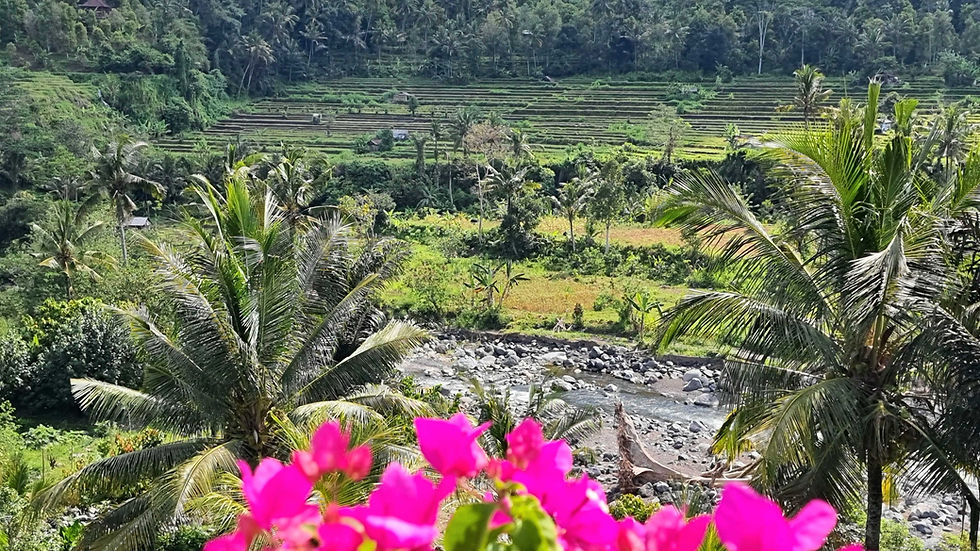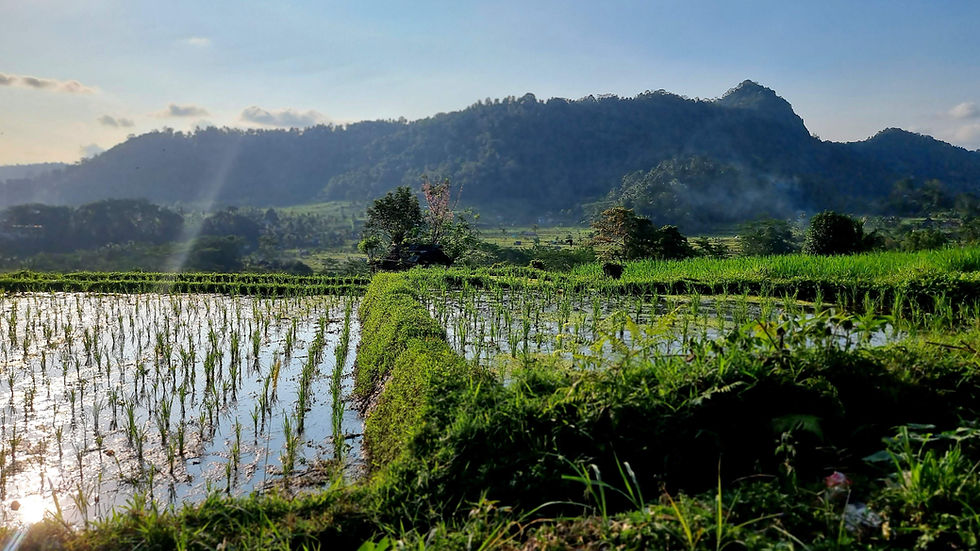In the Shadow of Agung - Sidemen’s Sacred Legacy
- Shannon
- Sep 18
- 4 min read
A working village shaped by ritual, history and the volcano that looms above.
Tucked into the emerald folds of eastern Bali, Sidemen is a village seemingly preserved in time, its quiet beauty masking layers of history, mysticism and ancient power. Long before it became a retreat for travellers seeking serenity, Sidemen was the cradle of sacred agricultural rituals and spiritual learning. Oral traditions trace the village’s origins back to Bali’s earliest kingdoms, with legends suggesting that Sidemen was once a favoured training ground for priests and ascetics drawn to the area's potent energy and its proximity to Mount Agung, the island’s most sacred volcano. The name “Sidemen” itself, believed to come from sida (to attain) and mahan (greatness), hints at its spiritual legacy as a place where seekers pursued enlightenment and communion with the divine.

Beyond its ethereal beauty, Sidemen is known for being a gateway to ancient rituals and darker folklore. Locals whisper of the Leyak, a Balinese witch spirit, said to roam the rice fields and riverbanks after dark, preying on those who disrespect the land or the gods. This myth is deeply tied to the belief that Mount Agung is not just a physical peak but the cosmic pillar connecting the underworld, the earthly realm and the divine. During times of volcanic unrest, villagers often interpret it as a sign of imbalance, of spiritual corruption or ancestral displeasure and perform cleansing ceremonies to appease unseen forces. Visitors drawn to Sidemen’s stillness may not realise that this serenity is carefully maintained through generations of spiritual vigilance.

The village’s cultural richness is matched by its artisanal mastery, particularly in weaving. Sidemen is one of the last strongholds of the traditional endek and songket weaving techniques, where patterns are not merely decorative but symbolic, representing protection, fertility or divine favor. Many weavers are descendants of guilds once commissioned by Bali’s royal courts and their work continues to be sought after for temple ceremonies and sacred attire. Yet, some villagers still speak of cursed textiles, ritual garments infused with ancestral energy that must never be sold or worn casually, lest they bring misfortune. These tales remind outsiders that craftsmanship here is not just commerce, it is a spiritual act.

Despite its peaceful façade, Sidemen has experienced its share of historical turbulence, particularly during the mid-20th century. During the Indonesian communist purge of 1965 and 1966, the nearby Karangasem region witnessed brutal violence, as ideological conflicts clashed with spiritual authority and traditional power structures. Priests, accused of harbouring forbidden knowledge or allegiances, vanished. Some say the rivers around Sidemen ran red in those days and sacred groves became makeshift burial grounds. Even now, older residents are cautious about discussing those years, suggesting that the land itself has not forgotten the blood spilled on it.

Still, Sidemen remains a stronghold of Bali Aga culture, a threadbare lineage of Balinese life that predates Hindu-Javanese influence. Their animist beliefs and isolated customs survive in hidden pockets of the village, visible in ancestral shrines made of stone and wood, unmarked by modern Hindu symbolism. These sites, often tucked away from the main paths, are places of quiet reverence. If you’re lucky, or respectful enough, a local might guide you to one of these sacred groves where offerings are made not just to gods but to the spirits of the land itself, ancient guardians known to punish greed, theft or arrogance.

For those who come not only to observe but to participate in Bali’s living spirituality, Sidemen offers an immersive experience. The village is home to a disproportionate number of pemangku (temple priests) and balian (traditional healers), many of whom offer consultations, blessings or energy work rooted in centuries-old teachings. Retreats in the area often include fire rituals, water purifications and sunrise meditations facing Mount Agung. Yet not all spiritual interactions are light. Several visitors have reported unsettling dreams or strange encounters after participating in certain ceremonies, reminders that true spiritual engagement in Bali is a powerful, often unpredictable path.
Today, Sidemen walks a delicate balance between past and present. While eco-villas and organic restaurants have appeared, development is tempered by a deep sense of duty to preserve what is sacred. Unlike Ubud’s bohemian bustle or Canggu’s digital chaos, Sidemen’s tourism is built around respect, not reinvention. Even its royal family, still present in the area, has played a role in shaping responsible tourism, having opened the first homestays in the 1980s not as a business but as an act of cultural exchange. Here, visitors are not consumers, they’re witnesses to an ancient, breathing world where beauty and darkness, silence and ritual, exist in inseparable harmony.

🗺️ Location
Sidemen Village, Karangasem Regency, East Bali, Indonesia
🚆 How to get there
Getting to Sidemen takes approximately 1 1/2 hours by car from Ubud and around 2 1/2 hours from Denpasar, depending on traffic and weather conditions.. The journey itself winds through scenic countryside, passing rice terraces, small villages, and quiet backroads, offering a glimpse into the island’s more traditional and untouched side. Because of its remote location, Sidemen feels worlds away from the crowds of southern Bali. It’s highly recommended to allocate at least 2–3 nights in the area, not just because of the travel time but because Sidemen is also a peaceful and strategic base for exploring East Bali. From here, you can easily access Tirta Gangga, Besakih Temple and even trek up Mount Agung, while still returning each evening to the serenity of the valley. Hiring a private driver from Ubud to Sidemen typically costs around 350000 IDR (approximately $35 AUD), while a trip from the southern beach areas usually runs closer to 650000 IDR. Ride-hailing services like Gojek are rarely available in Sidemen and local taxis can be hard to find. For these reasons, arranging a private driver is often the most convenient and reliable way to travel between Ubud, the southern beaches and Sidemen.
Thanks for reading In the Shadow of Agung - Sidemen’s Sacred Legacy. Check out more awesome destinations here!

In the shadow of Agung, Sidemen’s sacred legacy endures, etched into its valleys, temples and timeless traditions





















